False Nutsedge, Strawcolored Flatsedge, Strawcolor Nutgrass - Cyperus strigosus
|
Cyperus strigosus - False Nutsedge, Strawcolored Flatsedge, Strawcolor Nutgrass. Sedges (and grasses) are notoriously difficult to identify to the species. On top of that, Cyperus is a HUGE genus, with around 600 species in the world, and over 90 (most native) in North America. Add to that my status as a rank amateur, and it is with great trepidation that I approach this identification. Fortunately Cyperus strigosus is one of the more common sedge species, so at least that increases the odds that I have this identification correct.
Alaska is the only state with no Cyperus species. Several species are very widely distributed, with 7 species being found in at least 44 states, based on USDA maps. Cyperus strigosus is one of those 7 species. It is missing only from Alaska and Hawaii, plus four great plains states - Montana, Wyoming, Colorado, and North Dakota.
Found in:
AL, AR, AZ, CA,CT, DC, DE, FL, GA, IA, ID, IL, IN, KS, KY, LA, MA, MD, ME, MI, MN, MO, MS, NC, NE, NH, NJ, NM, NV, NY, OH, OK, OR, PA, RI, SC, SD, TN, TX, UT, VA, VT, WA, WI, WV
Leave comments on Cyperus strigosus at this link. | 
Distribution of Cyperus strigosus in the United States and Canada:
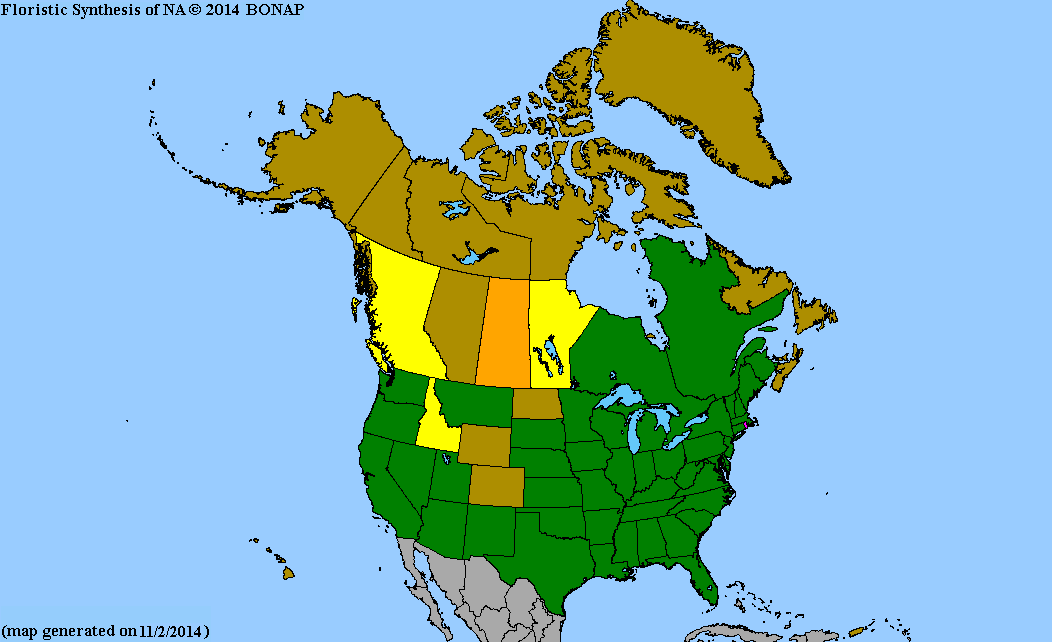
Map courtesy of The Biota of North America Program.
Map color key
Search Our Database: Enter any portion of the Scientific, Common Name, or both.
Do a general Google search of the entire site:
#ad
 Follow USWildflowers on Twitter
#ad
| | Site: Walker County, GA Date: 2013-September-05 | Photographer: Gerald C. Williamson
Nikon D7000
Tamron SP 90MM f/2.8 AF Macro | | The inflorescence of Cyperus strigosus is an ovoid to cylinder-shaped spike with up to 50 spikelets (usually many fewer) in each. The lower spikelets may be reflexed and the top ones ascending; the majority are spreading. | | 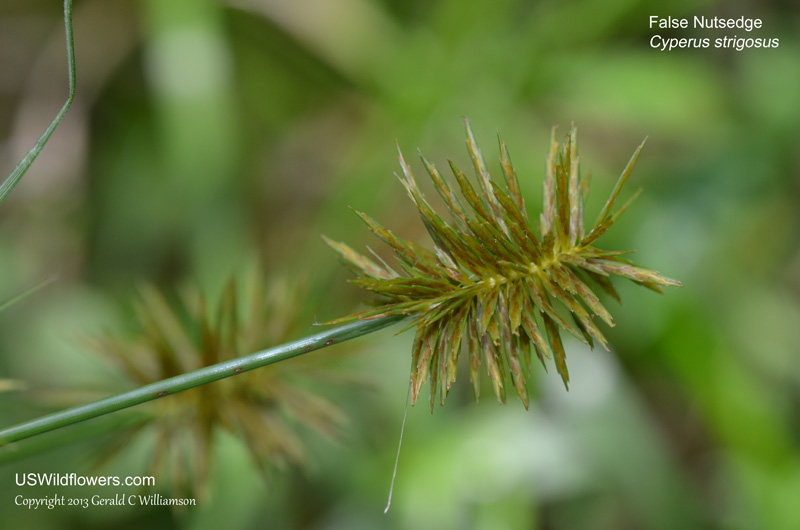
| | Site: Walker County, GA Date: 2013-September-05 | Photographer: Gerald C Williamson
Nikon D7000 | | The flowers of False Nutsedge consist of overlapping brownish-green floral scales, 3 to 8 of them on each spikelet within the inflorescence. While the floral spikelet of the inflorescense is somewhat flattened - wider than it is thick - the rachilla (the central stem upon which the floral scales grow) is nearly round ("subterete"). | | Click on the photo for a larger image
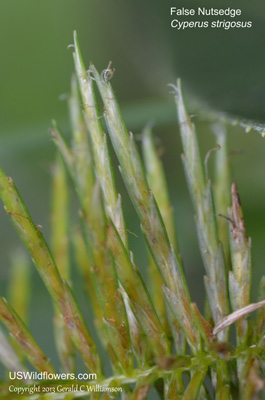
| | Site: Walker County, GA Date: 2013-September-05 | Photographer: Gerald C Williamson
Nikon D7000 | | The inflorescence is a terminal umbel with several long, narrow bracts under the inflorescence. | | Click on the photo for a larger image
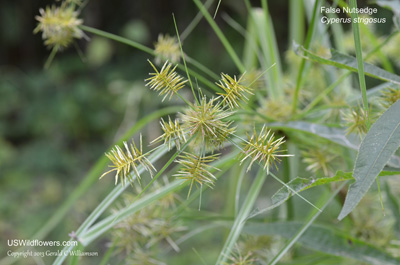
| | Site: Walker County, GA Date: 2013-September-05 | Photographer: Gerald C Williamson
Nikon D7000 | | Both the stem and leaves of Cyperus strigosus are strigose - marked with fine grooves or streaks. The basal leaves sheath the stem. | | Click on the photo for a larger image
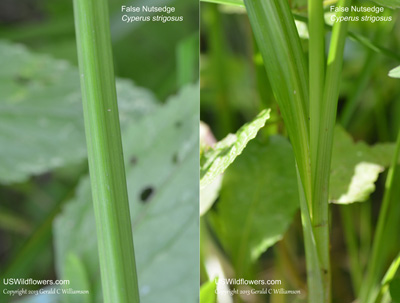
| | Site: Walker County, GA Date: 2013-September-05 | Photographer: Gerald C Williamson
Nikon D7000 | | False Nutsedge grows to about 2 feet tall or a bit more, with several grass-like basal leaves growing as tall as the stem. The narrow bracts that subtend the inflorescence are leaflike, but narrower than the true leaves of the plant. | | Click on the photo for a larger image
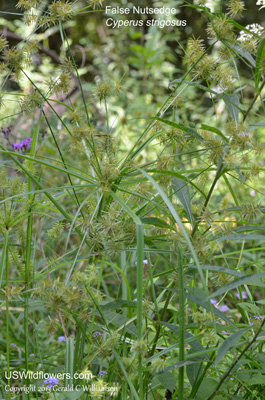
| | Site: Walker County, GA Date: 2013-December-07 | Photographer: Gerald C Williamson
Nikon D7000
Tamron SP 90MM f/2.8 AF Macro | | I've seen this poem - "Sedges have edges, Rushes are round, and Grasses have nodes where leaves are found." Those edges for sedges are from the usually triangular shape of the stem, as shown here. It should be noted that the stems of grasses as well as rushes are usually round - with grass stems hollow between the leaf nodes, and rush stems (as well as sedge stems) being solid. That "solid" is a sponge-like solid. | | Click on the photo for a larger image
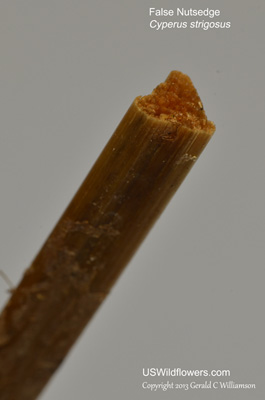
| | Site: Walker County, GA Date: 2013-December-07 | Photographer: Gerald C Williamson
Nikon D7000 | | Flora of North America says that C. strigosus has deciduous floral scales, but the keys in Weakley's Flora of the Southern and Mid-Atlantic States has it listed both in the section for Cyperus with deciduous floral scales and the section with persistent floral scales. This photo might explain why it's in both sections. The rachillas (the central stem of the spikelets) are also listed as more or less deciduous, with this photo supporting that observation. | | Click on the photo for a larger image
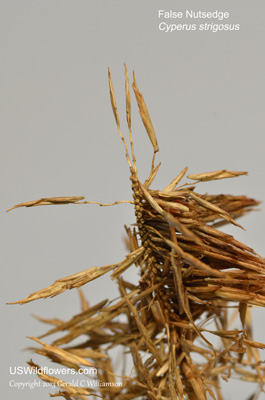
|
References used for identification and information:
|
|
| |
| #ad
|
|









